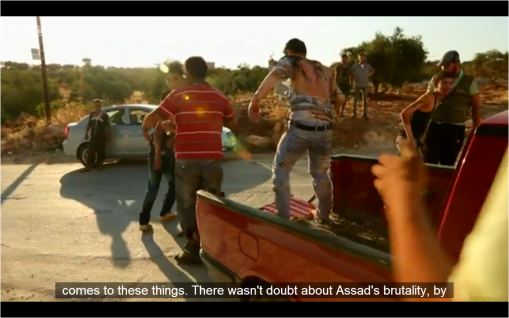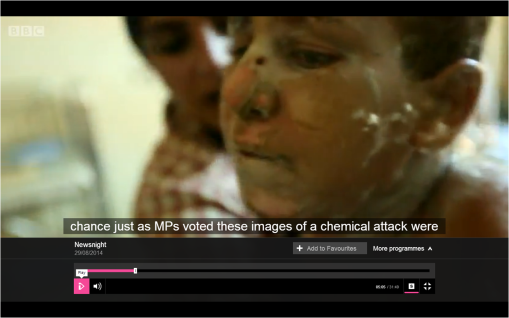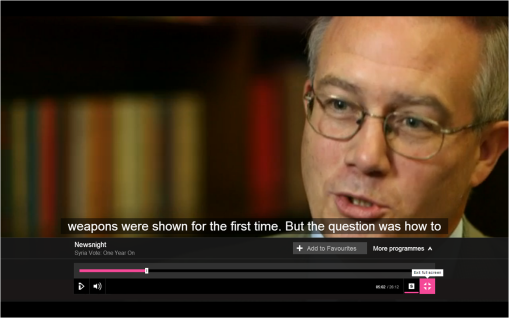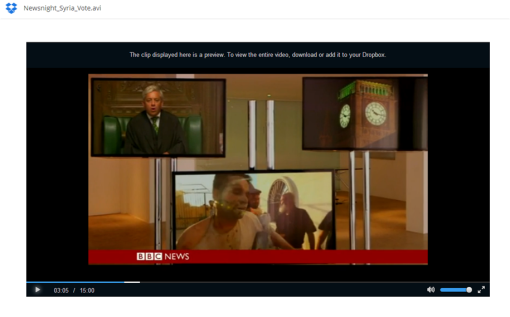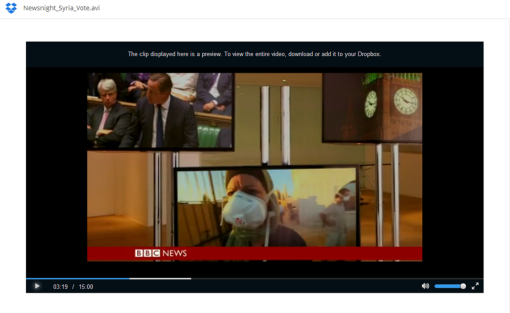Fake TV Images: BBC Admits “Switching Syria Footage” On Grounds of “Taste and Decency”

One hundred and eleven working days after the BBC said its reply may “take longer than 20 working days” I have received the below response to my letter of 5 November 2014 regarding the substitution of footage between two transmissions of an August 2014 edition of Newsnight.
After chasing via the BBC complaints webform and by telephone since February 2015, I was today informed by BBC Audience Services that a response had been posted to me on 11 May. As I had not received the letter, the customer services representative to whom I spoke agreed to email it to me, which promptly occurred.
The substance of the complaint
As discussed here, the 29 August 2014 edition of Newsnight included (from 04:49) footage from the alleged 26 August 2013 Aleppo playground napalm bomb incident, accompanied by Chief Correspondent Laura Kuenssberg’s narration “by chance, just as MPs voted, these images of a chemical attack were shown for the first time”. This was correct inasmuch as the BBC 10 O’clock News of Thursday 29 August 2013 did indeed broadcast these images at the precise moment MPs were voting on the government’s motion on Syrian intervention. The veracity of Ian Pannell and Darren Conway’s reports is, however, strongly disputed.
A few hours later, at 4:30am on 30 August 2014, the BBC News Channel transmitted a re-edited edition of the same Newsnight programme, entitled Syria Vote: One Year On [1]. In this version (from 0:44) the “napalm bomb” images had been substituted with footage from an entirely different event, an alleged chemical attack on Saraqeb, Northern Syria on 29 April 2013, first broadcast in another Ian Pannell BBC News report of 16 May 2013. However, as can be seen from the subtitles in the screengrabs below, the narration continued to inform BBC viewers that the images on screen had been “shown for the first time” “by chance, just as MPs voted” – i.e. at around 10:17pm on the evening of 29 August 2013.[2]
In my letter of November 2014 I observed that the substitution is a self-evident breach of the BBC’s commitment to “achieving due accuracy” as set out in Section 3.1 of the Editorial Guidelines.
In considering the BBC’s response note that following the 29 August 2014 transmission I had pointed out to Ms Kuenssberg that the alleged Aleppo attack had been definitively ascribed by the BBC to an incendiary munition and that her reference to a “chemical attack” was therefore inaccurate [3]. The footage from Saraqeb which was substituted some hours later had been reported in Ian Pannell’s May 2013 report as a “chemical attack”.
Reply from BBC Audience Services, 11 May 2015 (received by email 17 May 2015)
Reference CAS-3014042-NZY8X7
Thank you for contacting us.
I am sorry for the delay in responding to your complaint. We realise that our correspondents appreciate a quick response and we’re sorry that you had to wait on this occasion.
The pictures used on Newsnight on BBC TWO were more graphic and as the programme is shown after the watershed to UK audiences that is within audience expectations.
However as the version going out on the BBC News Channel is also broadcast around the world on BBC World News we have to be more careful in terms of taste and decency to our audience elsewhere in different time zones.
We would also re-iterate the point we made in our first response that the change of pictures did not change the journalistic integrity of the piece so we feel it is editorially justified and in line with BBC editorial guidelines.
We are sorry to tell you that we have nothing further to add. If you would like to take your complaint further, you can contact Stage 2 of the complaints process, the BBC’s Editorial Complaints Unit, within 20 working days, and they will carry out an independent investigation. You can email them at: [email protected] , or alternatively write to them at the following address:
Editorial Complaints Unit
Broadcast Centre
BC2 B4
201 Wood Lane
London
W12 7TP
Should you choose to escalate your complaint we would ask that you include the reference number provided above in your correspondence.
Thank you again for contacting us.
Kind regards,
BBC Complaints team
Assessment
This explanation would appear – in the very least of its implications – to give the BBC News Channel carte blanche to broadcast, without any acknowledgement, inauthentic images in accompaniment to any domestic BBC report originally broadcast post-watershed and deemed to have breached unspecified standards of “taste and decency”.
A search on the BBC Editorial Guidelines webpages returns no results for the terms “taste” or “decency”. What are the criteria and who determines when these standards have been breached? Further, what criteria must apply to images which are substituted for reasons of “taste and decency”? Must they be from the same region as the original incident? The same country? Within two years of the original event? Five? Ten? Who decides? Can the BBC News Channel show a Tom and Jerry cartoon in place of graphic images?
Moreover, even in its own terms the BBC’s response is incoherent :
- As demonstrated by this screengrab, the edition of Newsnight in question was deemed tasteful and decent enough to be posted on iPlayer for seven days without a parental guidance flag for those later accessing it pre-watershed.
- Scenes from Ian Pannell’s “playground napalm bomb” report were in fact seen “elsewhere in different time zones” by viewers of Syria Vote: One Year On: they featured as part of a collage of footage from 3:00 – 3:20 minutes in the programme, precisely as they had in the original Newsnight broadcast (see further screengrabs below). This collage includes the sequence of Mohammed Asi arriving at Atareb Hospital “like the walking dead” which can scarcely be considered any less graphic than the scenes which were removed for the BBC News Channel.
Screengrabs from Newsnight (BBC2, 29 August 2014, 22:30)
Section commencing 04:49. Footage is from Syria crisis: Incendiary bomb victims ‘like the walking dead, BBC 10 O’Clock News, 29 August 2013.
Screengrabs from Syria Vote: One Year On (BBC News Channel, 30 August 2014, 04:30 & 14.30)
Section commencing 04:44. Footage is from Syrians describe effects of alleged chemical attack, BBC News, 16 May 2013.
“Napalm bomb” footage included in both broadcasts (3:00 – 3:20)
Notes
[1] The links provided here to both versions of the Newsnight programme open onto 15 minute previews. It is necessary to download the files in order to view the full editions.
[2] The first screengrab in the series is significant in respect of the broader charges of fabrication against Ian Pannell and Darren Conway’s reports.
[3] On 2 December 2013 BBC Audience Services wrote in reply to my complaint about Ian Pannell’s 29 August 2013 report:
The phrase “chemical weapon” was taken out of the news piece because by the time it was broadcast it was known that this was an incendiary bomb that had been used in the attack. Ian Pannell mentions this on two occasions in his script prior to the clip of Dr. Rola. To have included her speculation that this could have been a “chemical weapon” ran a considerable risk of being incredibly misleading and confusing to the audience, not least because the incident happened within days of an alleged chemical attack in Damascus.
The BBC’s reply further states that, despite the “initial fear” at the hospital being of a chemical attack, “it later became clear that a napalm-type substance had been used”.


